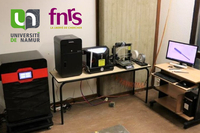3D-printed swabs “Made in UNamur” successfully passed the final round of clinical testing
During the first wave of Covid-19, supply of nasopharyngeal swabs turned out to be insufficient to cover Covid-19 testing needs and rapidly became a critical bottleneck to the expansion of diagnostic capacity in Belgium. Besides swab shortages, other drawbacks reported with commercially available devices are the swabbing‐induced discomfort and the potential contamination risks while handling samples.
To address these issues, Prof. Stéphane Lucas (UNamur, Laboratory of Analysis by Nuclear Reaction - LARN) and Prof. Benoît Muylkens (UNamur, Integrated Veterinary Research Unit - URVI) had the idea to develop optimized sampling devices using 3D printing and plasma surface treatment technologies. This project relied on the strengths of two UNamur institutes: the strong expertise in material sciences from NISM and the solid experience in SARS-CoV2 molecular detection acquired during the set-up of the SANA diagnostic platform by NARILIS. The clinical validation in healthy volunteers was made possible thanks to a collaboration with Prof. Philippe Eloy, head of the ENT department of the CHU UCL Namur – Godinne.
Several rounds of design – production – validation with 8 different prototypes resulted in the emergence of a promising model. The clinical study, which received approval from the Ethics Committee of the CHU-UCL Namur, involved a total of 100 healthy volunteers to test the prototypes’ performances and required almost 900 PCR analyses. The most interesting prototype, called T2, was shown to collect a similar amount of biological material as the classical swabs, proving its performance. Moreover, the volunteers were asked to allocate a score for each sampling from 0/10 (very painful) to 10/10 (no discomfort). Statistical analysis demonstrated that the T2 model makes the swabbing procedure significantly more comfortable. Compared to the classical swabs which received a median note of 4/10 (very uncomfortable feeling), the T2 swabs were rated at median note of 7/10 (little discomfort feeling). This significant reduction in discomfort can be explained by the choice of materials used, rendering the device leaner and more flexible. The new prototype thereby adjust more easily in case of nasal septum deviation, a characteristic occurring in two thirds of people. Moreover, SARS-CoV-2 RT-PCR assays performed on collected samples allowed to identify individuals with asymptomatic infections among the volunteers. This supported furthermore that these new swabs are reliable to screen for viral agents.
The truly transdisciplinary approach adopted in this project, with the input from NISM, NARILIS and the CHU UCL Namur, has been the key to success in developing in a very short time more comfortable nasopharyngeal swabs which are infinitely reproducible. This work confirms that 3D printing can be an effective solution to address worldwide supply shortfalls. In addition, the work also paves the way for a valorization in pediatric medicine. A large number of samples are indeed not collected due to the lack of devices suitable for children. Another perspective is the possibility to make the swab surface virucidal in order to limit the contamination risks of clinical and laboratory staff. The concept of virucidal coatings is the subject of an ongoing PhD thesis under the direction of Prof. Stéphane Lucas. Finally, applications in the field of veterinary medicine are also under investigation.
The project received the support of the F.N.R.S. through an Urgent Research Credit (SWAB IMPROVEMENT, project n°40002771). The 3D printer installed at the LARN could be purchased thanks to donations from people and companies in response to the UNamur fundraising campaign for Covid-19 research.
SWAB IMPROVEMENT team
-
Prof. Stéphane Lucas, UNamur, NISM/NARILIS, LARN (promoter)
-
Prof. Benoît Muylkens, UNamur, NARILIS, URVI (co-promoter)
-
Dr. Sébastien Penninckx, UNamur, NARILIS, LARN (project manager)
-
Margot Cardinal, UNamur, LARN (lab technician)
-
Richard Coos, UNamur, NISM, LARN (electromechanics engineer)
-
Prof. Philippe Eloy, CHU UCL Namur, ENT Department (supervision of the clinical study)
-
Prof. Thierry Vander Borght, CHU UCL Namur, Department of Nuclear Medicine (supervision of the clinical study)
-
Dr. Anaïs Hanot & Dr Valentine Léonard, CHU UCL Namur, ENT Department (swab sampling)
Contact: sebastien.penninckx@unamur.be
 NAmur Research Institute for LIfe Sciences
NAmur Research Institute for LIfe Sciences


